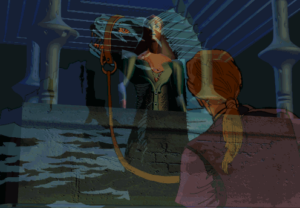There is this very Sirius (or Sirius Publishing, more precisely) family of video codecs (plus one container format) apparently developed by two guys (who like to spam their name even in junk sections of AVI files). Also initially it had its own container format but later they’ve started to target AVI.
Another peculiarity of this format is that initially it targeted games but later was also used as a crappy Video CD alternative.
Back in the day Gregory Montoir REd the original game format for one of the game engine re-implementations he’s famous for and donated the code to FFmpeg as well. Since that time I was curious whether that code can be adapted to play MVI1 and MVI2 as well but the codec itself turned me off.
The codec itself is perverted, both in code and interface. Also it’s inherently interlaced. Normally video codecs in AVI can be recognized by their FOURCC and pass additional configuration parameters in the additional header data. Here they decided to use half of FOURCC to pass configuration flags to the codec and use stream handler FOURCC (that most apps ignore) to tell their decoder should be used to handle it. This alone would make me want to not support it ever, but the binary specification is worse.
Looks like the code consists mostly of handwritten assembly because I don’t know which compiler may generate this madness. There are many versions of the codecs, most of them are 16-bit and the 32-bit version is no better. For starters, it uses segments.
Not so many people remember DOS times and its memory models, even fewer remember them fondly. And almost nobody remembers that in 32-bit mode you can also use FS and GS registers to have custom addressing modes. Well, this codec uses them: it sets FS to the context pointer so context fields are accessed as mov EAX, dword ptr[1A8h] while global variables are accessed as mov EAX, dword ptr GS:[SYM] and of course no decompiler likes that. I was able to work around it in Ghidra by creating a new segment starting from zero but it’s still annoying.
Another thing is (ab)using registers to the full extent. Functions pass their parameters implicitly in the registers, using stack only to save those values before a loop or form a list of rectangles to process. And of course it uses this annoying (for the decompiler) feature as using the same register for two loop counter (e.g. top byte for the outer loop and low byte for the inner loop). As the result Ghidra can’t decompile it properly or even ignores whole blocks of the code because to its belief they can’t be invoked—and it’s still better than decompiling 16-bit version of MVI1 which made decompiler commit suicide. As the result some functions are easier to hand-translate from the assembly.
In either case looks like despite all the improvements it remains about the same as the initial version: data is coded as 5-bit YUV internally and stored using Huffman codes, quantisation and change maps (rectangles that tell which areas to update/fill). MVI2 can use ten different frame decoding modes that differ in how the deltas are coded but essentially it remains the same. They have not even gotten to introducing a proper motion compensation it seems.
So, now I’ve had a good long look at the codec, found nothing interesting there that was not known before and can forget about it. If only there was something more interesting to look at…
